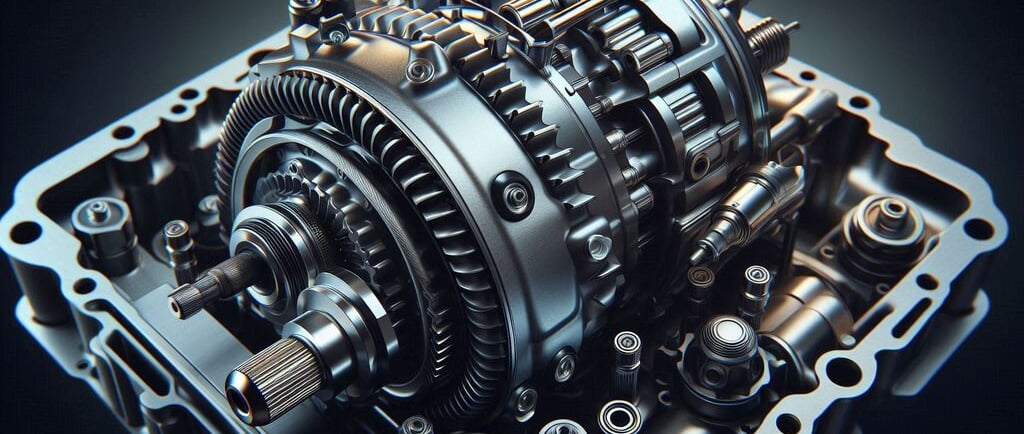Torque Converter (for automatic transmissions): Transfers and multiplies engine torque.
If you're driving a car with an automatic transmission, you might not think much about the torque converter, but this unsung hero plays a vital role in how your vehicle moves.
TRANSMISSION COMPONENTS
11/12/20244 min read


Torque Converter for Automatic Transmissions: Transfers and Multiplies Engine Torque
If you're driving a car with an automatic transmission, you might not think much about the torque converter, but this unsung hero plays a vital role in how your vehicle moves. The torque converter in an automatic transmission system is essential for transferring and multiplying engine torque, ensuring a smooth and efficient driving experience. Let’s dive into what a torque converter does, why it’s important, and how it impacts the performance of your vehicle.
What is a Torque Converter?
In simple terms, the torque converter is a fluid coupling device that connects your engine to the transmission. It serves as a medium through which engine power is transmitted to the transmission, enabling your car to move smoothly without the need for a clutch. While traditional manual transmissions rely on a clutch to engage and disengage the engine from the wheels, an automatic transmission relies on the torque converter to manage this process.
Key Components of a Torque Converter
Pump (or impeller): The pump is connected to the engine and is responsible for circulating fluid throughout the converter. As the engine runs, it spins the pump, which creates fluid flow.
Turbine: The turbine is connected to the transmission and receives fluid pressure from the pump. As fluid flows over the turbine blades, it causes the turbine to spin, which then turns the input shaft of the transmission.
Stator: Positioned between the pump and turbine, the stator redirects fluid coming off the turbine, optimizing efficiency and increasing torque multiplication.
Lock-Up Clutch: In modern torque converters, the lock-up clutch locks the turbine and pump together at higher speeds, providing a direct connection between the engine and transmission for better fuel efficiency.
How Does a Torque Converter Multiply Engine Torque?
One of the most important functions of a torque converter is its ability to multiply engine torque. But how does it do that? Torque multiplication occurs when the engine is under load or accelerating, and the fluid inside the converter is used to transfer power.
Fluid Dynamics: The Secret to Torque Multiplication
At lower speeds, the torque converter allows the engine to operate at a higher RPM while the vehicle moves at a lower speed. When the engine revs, the fluid from the pump flows into the turbine, creating pressure that spins the turbine. The stator then redirects the fluid, which causes the turbine to rotate faster than the pump. This interaction multiplies the engine torque, providing more power to the wheels without the need for a traditional clutch system.
Torque Converter Efficiency
While the torque converter is excellent at multiplying torque, it’s not always 100% efficient. The slip between the pump and turbine can cause some energy loss, which is why older automatic transmissions sometimes had a reputation for lower fuel efficiency. However, with advances in technology, modern torque converters are much more efficient. The lock-up clutch, for instance, eliminates slip at higher speeds, improving both efficiency and performance.
Why Is a Torque Converter Important for Automatic Transmissions?
Smooth Gear Shifting
In an automatic transmission, gear shifts happen seamlessly without the driver’s intervention. The torque converter helps achieve this smooth transition by automatically adjusting the amount of torque that’s sent to the transmission. When the engine speed increases or decreases, the converter regulates the fluid flow, ensuring a consistent transfer of power to the wheels.
Enhanced Acceleration and Performance
Because the torque converter can multiply torque, it plays a key role in your car’s acceleration. When you press the accelerator, the torque converter increases the amount of power being delivered to the wheels, making the car accelerate smoothly and quickly. This is especially noticeable when you’re driving uphill or towing a heavy load.
Prevents Stalling
Another critical function of the torque converter is preventing engine stalling. The torque converter allows the engine to keep running even when the vehicle is at a standstill, like at a red light. It enables the engine to continue turning without the need for the driver to disengage the clutch, making it easier to control the vehicle in various driving situations.
Signs of a Failing Torque Converter
Just like any other car component, torque converters can wear out over time. If you’re experiencing any of the following symptoms, your torque converter might be failing:
Slipping: If your car feels like it’s hesitating to accelerate or if the RPMs increase without a corresponding increase in speed, your torque converter might be slipping.
Overheating: Excessive heat is a common issue with a failing torque converter. If your vehicle is overheating or if you notice the transmission fluid is discolored or burnt, it’s worth having your torque converter checked.
Rough Shifting: If your automatic transmission is shifting roughly or erratically, the torque converter could be to blame. A malfunctioning converter can cause erratic pressure, affecting how smoothly the transmission shifts.
Strange Noises: Unusual sounds like whining, grinding, or clunking noises may indicate a problem with the torque converter.
Conclusion: Understanding the Torque Converter’s Role in Your Vehicle
The torque converter is a critical component of any automatic transmission, playing a key role in transferring and multiplying engine torque to ensure smooth performance and efficient acceleration. While it works behind the scenes, its function is indispensable for the smooth operation of your vehicle, especially in modern automatic transmissions with lock-up technology. Regular maintenance and monitoring of symptoms like slipping, overheating, or rough shifting can help you ensure that your torque converter is working efficiently.



